There has been a flurry of interest just recently with the release of an online map showing where in NZ cyclists have suffered “dooring” crashes, i.e. they have been hit by an opening door of a parked car as they’ve gone past. Prompted by a recent cycling fatality in Dunedin, Otago University researchers decided to collate the statistics for all dooring crashes around the country between 2007-11 and present them on a public Google map.
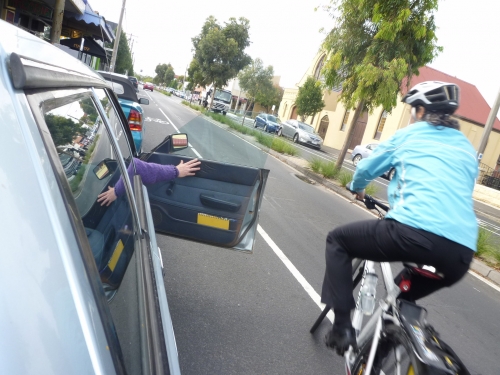
Of local interest is that Riccarton Road has been identified as the top location in the country for dooring crashes. In some ways this is not surprising, as this is one of the busiest cycling routes in Christchurch that doesn’t have existing cycle facilities. But there were also a good smattering right across the city – over 70 recorded crashes in the five years studied (and no doubt many more not reported).
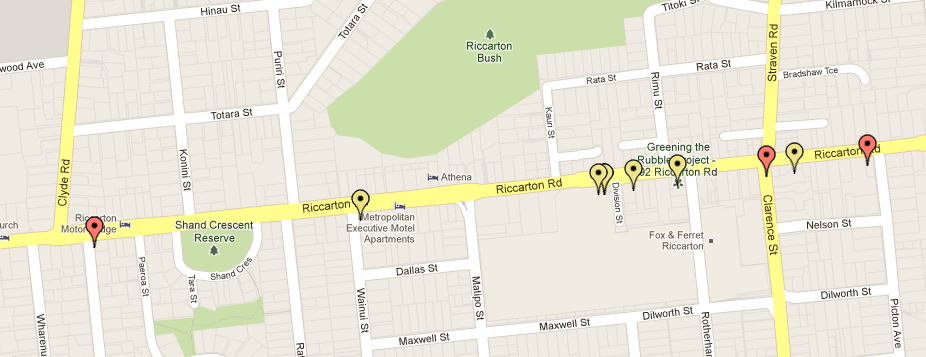
So what can be done to combat this issue? There are a range of approaches:
- Obviously motor vehicle occupants can be encouraged to be more careful when getting out of their cars. Let’s be quite clear – it is an offence to carelessly open your car door and hit a passing cyclist (Clause 7.2, Road User Rule). Around 2000, Christchurch City had a campaign of distributing stickers to remind motorists of this hazard – small ones were put next to door handles and larger ones in the back window. Perhaps we should resurrect this campaign again?
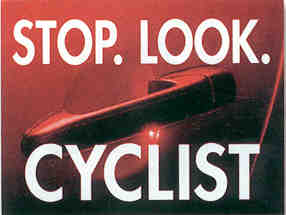
(Another useful suggestion is that drivers should open their door using their left hand, not their right one. This simple action forces them to turn their body to better see any oncoming cyclists.)
- People cycling also need to take care themselves. It gives me the heebie-jeebies to see how close many riders get when passing parked cars. Typical car doors can open out about 0.7-0.9m. A simple rule of thumb for starters – if you can reach out and touch the car you are too close. Also, as you’re approaching, try to take note of whether you can see an occupant inside the car that you may have to watch out for. Well-designed cycle lanes next to parked cars generally already include a buffer space for doors, so don’t ride down the middle of them; ride in the right-hand half. Some of the more recent cycle lanes in Chch even have markings to help you. If there isn’t a cycle lane you’ll just have to use the “arms-length” test to work out whereabouts you should be placed (maybe in the future we’ll start providing some “sharrow” markings to help you there).
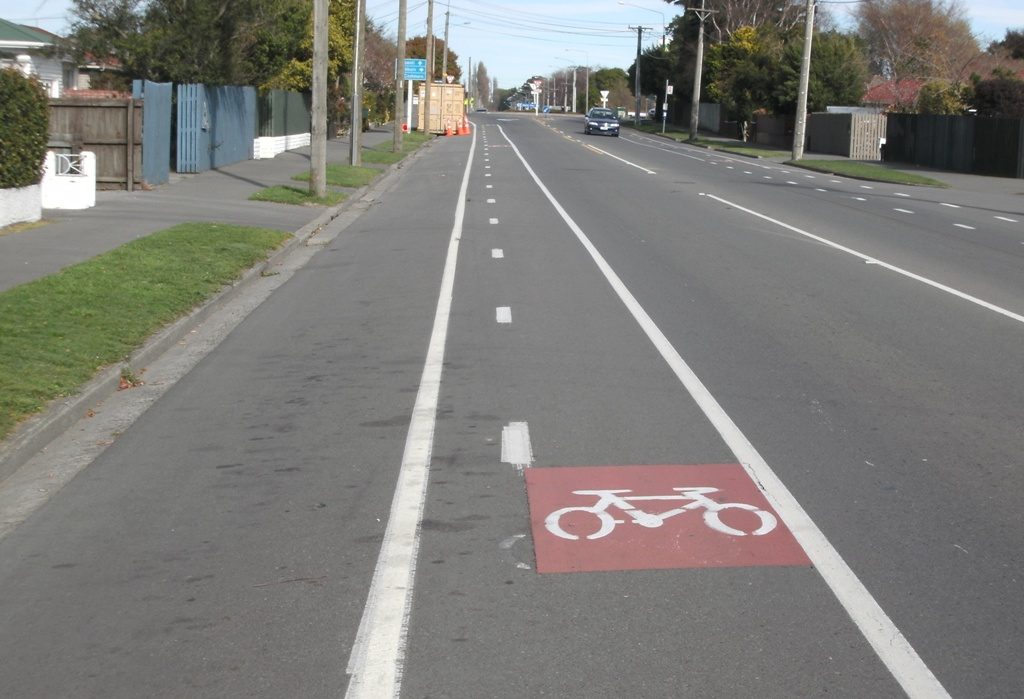
- Many people quite naturally are a bit wary of shifting further to the right to avoid parked cars; they’re worried about the moving vehicles passing them on their right. That’s understandable but actually, in the main, motorists are pretty good at adjusting their position depending on where you are positioned. An interesting bit of informal research done in Wellington confirmed that most passing distances by motorists were greater than the recommended 1.5m but also that there was no correlation between cyclist position and passing distance by motorists. In fact, if anything, drivers were likely to give you an even wider berth if you were further out. That makes sense – the more you are in a driver’s field of vision (and not off to the periphery) they are likely to notice you and try to avoid you.
- The above points rely on both cyclists and motorists looking out for each other. The other solution is to develop infrastructure that minimises the problem. Ensure that painted cycle lanes are well-dimensioned (ideally 1.8m) to provide some buffer space. If things are really getting squeezed up, consider removing some parking to eliminate the pinch-point. Or look at developing separated cycleways with buffers so that passenger-side doors don’t also create problems.
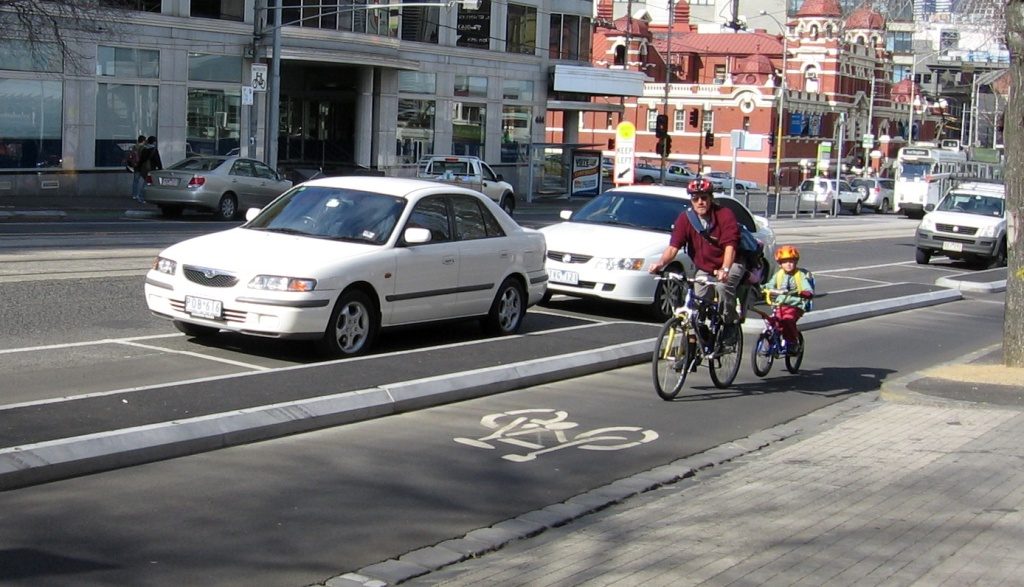
If all of these things are done, then hopefully the dooring problem will be greatly reduced. In the interim, while you are waiting for better motorist behaviour and separated bikeways, just make sure you position yourself in a safe place to avoid those doorings!

Another thing worth mentioning is pre-planned behaviour if you encounter a door opening and can’t avoid it. Just like what defensive driving teaches with an unavoidable incoming car….hard left!
Most fatalities on ‘dooring’ occur because the door knocks the cyclist off and into the traffic. An experienced motocross friend says ‘throw yourself into the car’ far better than under the following truck
Aiming towards the car in response to a door opening has a huge risk. That door is very sharp, and it gets sharper and a lot harder the closer it is to closed. If the driver sees the bike they will pull the door in, but if they already have a foot out they can’t close it completely.
Here’s an updated (temporary) link for the Wellington info – we’re working through some WordPress problems… https://cycwell.wordpress.com/2012/10/08/minding-the-gap-and-the-door-zone/
I still have some stickers! The road safety committee supported them after my 1998 car dooring that left me in intensive care for 3 weeks and hospital for 3 months .
Sometimes I’m inclined to think that the cycle lane is just the 100mm wide white lane marking.
I have been "Doored" 3 times in recent years. Last one off work nearly a year. It may be an offence to open a car door and hit a cyclist, however in my case the driver had 3 witnesses and I had none. So, police said not in their interest to prosecute as the cost of getting it to court was much too high compared to the fine that may be imposed.
What the hell…
So when I have to ride beside parked cars I do ride quite close on the basis that as the door opens I can steer into the gap and use the door to take the impact and maybe get the driver as well. It works!
Using the left hand to open the door would be a good thing for a public education campaign. It is law in Holland isn’t it?
People claim to care about injuring other people but history shows they care a hell of a lot more about the risk of legal penalties and of being held by a court to have been in the wrong when someone was injured. That’s why we have big penalties for drunk driving.
My Corolla 4 door opens 900mm, so wouldn’t big cars and SUVs open more?
I thought I was safe when I was doored and bounced into the middle of the lane in rush hour. It was a 2 door car, they have much longer doors.
Those dotted lines to indicate the door zone make no sense to me – doors open far wider than that. I think they are actively luring cyclists into the door zone. Or is the idea that they indicate where a minimally opened door comes to, and when people open wider than that it is just bad luck?
Vigorously pursuing legal action against people who ‘door’. Lobby politicians to stop police being soft on people who ‘door’ cyclists. Currently unless injury involves overnight care in hospital Northland police only give warnings for ‘dooring’. Campaign for greater driver awareness. To be honest this article is like telling girls to wear sensible skirts or they might get raped instead of telling men to not rape. An apology for bad drivers in general.